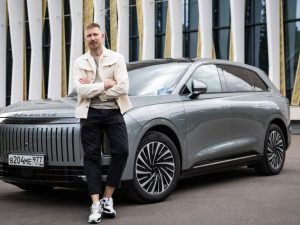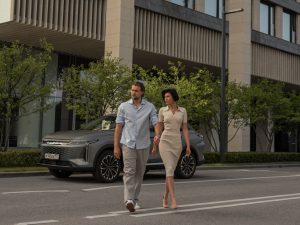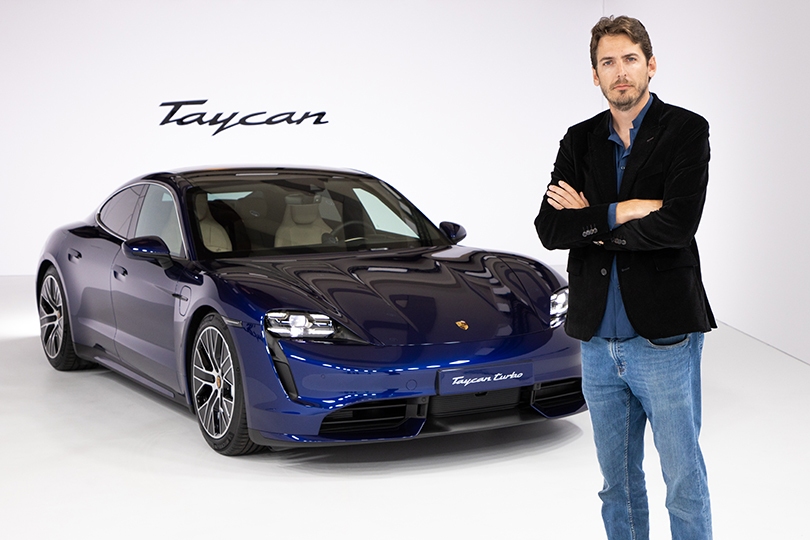The day has finally come. Four years after Porsche teased us with their Mission E concept car, they’ve now launched their very first electric car and named it Taycan. And they wouldn’t be Porsche if they weren’t aiming high. Very high.
It’s a rare enough occurrence for Porsche to launch an all new model, but the Taycan is doubly special because it’s also their first go at building a battery-powered electric car. To underscore just how big of a deal it is, the car’s world premiere took place simultaneously in three different locations. On three different continents, in fact, and all of it was live streamed around the world. I found myself in what was certainly the most picturesque and impressive of the three locations: Niagara Falls, Canada. As soon as the car itself was revealed by driving onto the stage — whisper quiet, as EVs do — the rear wall rotated away to provide the American side of Niagara Falls as the stunning backdrop to a no less stunning white Taycan Turbo S. One has to give it to them, they do know a thing or two about showmanship.
![]()
I am aware of the fact that I have been known, on occasion, to give car manufacturers a hard time about some of their silly naming schemes. On the face of things, putting a Turbo badge on a car that is powered by electric motors and batteries would be an open goal for me to make some mildly entertaining jokes about. But when it comes to the Taycan Turbo, I feel like maybe cutting them a bit of slack is justified. At least it’s entirely in line with the way Porsche names all its other cars. The most powerful versions are called Turbo, so at least we’re getting consistency in the absence of descriptive accuracy. Any unsuspecting passengers who get a ride in a Taycan will probably not doubt the “Turbo” factor anyway. So giving them a pass it is, then. It’s got nothing to do with the fact that they flew me halfway across the world to witness the car’s launch right next to one of the natural wonders of the world, I swear.
![]()
Plenty of fuss had been made online about the fact that the many Taycan prototypes that have been photographed during development did not look particularly… good. Certainly not as good as the Mission E prototype which positively wowed the car world back in 2015. But I suspect that anyone who sees the Taycan in the flesh is going to be fairly impressed with the way it looks. Certainly the design had to be toned down a little bit from the concept stage in order to, you know, be road legal. But I found it positively gorgeous to look at from most angles, and especially the front end is genuinely close to what the concept was. On a first viewing, the air inlets on the front bumper that come down from the headlights give the Taycan a slight McLaren vibe perhaps, but those are probably not going to be as prominent if you get the Taycan in any colour other than the bright white that was used for the cars of the premiere. The proportions of the car are just right, and very sleek for what is a four door car with ample passenger space. Taste is of course a personal matter, but among many car journalists there the general consensus seemed to be in line with my own perceptions.
![]()
One thing that Porsche is doing differently with the Taycan is launching the top models first. So we get the Turbo and Turbo S initially, with “4S” and base models to follow later down the line. Both cars have a 93.4 kWh battery pack and dual electric motors for all-wheel-drive, so the main difference between the two is simply a matter of maximum power. The Turbo gets a peak number of 680 horsepower while the Turbo S goes all the way up to 761. Porsche always quotes its power numbers in “PS” but those are close enough to a horsepower that it makes no real difference. Acceleration figures for the Turbo are 3.2 seconds to 100 kilometers per hour while the Turbo S can do it in a mere 2.8. The latter can also reach 200 kilometers per hour in a scarcely believable 9.8 seconds, while top speed is capped at 260 kilometers per hour. In other words, these are mentally quick cars which will scare the pants off of most people. Especially because all that power and torque generated by the electric motors is both immediate and unrelenting in a way that a regular combustion engine simply cannot provide.
![]()
What sets the Taycan apart from all other EVs right now is that it operates at 800 Volts, twice that of most other electric cars. Doubling the voltage means that you only need half as much current to transport a particular amount of power, which means less heat and higher efficiency. That has allowed Porsche to charge the Taycan at rates of up to 270 kW, with 350 kW becoming possible in the future. If these numbers are meaningless to you, as they probably are to most people, it just means Taycan can charge faster than any other electric car on the market. Adding 100 kilometers of range can be done in only 5 minutes, and a full charge can be done in well under half an hour.
The driving ranges are quoted as 450 kilometers for the Turbo and 412 for the Turbo S, according to the WLTP driving cycle. Expect somewhat less than that in real life, as these standardized test cycles are never truely representative for real life driving. I’m not actually sure why the Turbo S gets less far on a single charge given that it uses the exact same battery, but I’ll make sure to ask Porsche about that when I get to drive the car in real life.
I did already speak to some very interesting experts from Porsche the night before the official unveiling, Joachim Krämer and Steffen König — directors for the Taycan’s Electronics and Body respectively. Below are some of the answers they gave to the questions that I managed to get in whilst simultaneously checking out the Taycan that was on site for a very exclusive sneak peak.
![]()
— The European EVs that we’ve seen thus far have all been SUVs or crossovers. Why did Porsche decide to make their first electric car a sports sedan?
— Well we are Porsche, and making sports cars is in our DNA. In terms of size, it’s more or less in between the 911 and the Panamera which means that we could make it really drive like a sports car. If you compare the Taycan to the Mission E concept you will see that there are actually no big differences, outside of the fact that we of course had to lose the crazy doors that we put on the concept car.
— The front of the car is very distinctive, especially with the air inlets on the front bumper. I suppose these fulfill an important aerodynamic purpose?
— Exactly, we had to work very hard to make this car as efficient as possible and we achieved a very good Cx value of 0.22. The vents on the front bumper vent the air out of the wheel well to create a kind of air curtain on the side of the car which helps to reduce the drag from the rotating wheels and tires.
— Looking back now at the whole process of making this car, which part or which target was the hardest to achieve?
— The most difficult part was creating all the parts for the electrical drivetrain from scratch because of course we had never done this before.
![]()
— The Taycan features very impressive fast charging with its 800 Volt battery system, but will the first customers be able to find many charging stations that can charge this quickly?
— Actually there are already quite a number of fast charging points already in Europe with Ionity and in the States now there is “electrify America” which is building many charging points. Still we expect that 80 or 90 percent of all charging will take place at home — an 11 kW charger comes with the car so that can completely charge the Taycan’s battery overnight. It’s only when people really start driving long distances for example to go on vacation then they would use these super fast charging points.
— Many of the biggest brands in the car industry are betting heavily on electric cars and are bringing a huge amount of production capacity for EVs online. Do you think there will be enough demand from consumers to match it?
— Of course, nobody knows exactly how it will go but in our opinion the best way to make people want an electric car is to let them drive one… people who try it it will be impressed with the immediate torque and the performance of the car not to mention how quiet it is. This kind of mentality can change really quickly, so it will be interesting to see what happens. We’ve seen it time and again that as soon as somebody drives an electric car… they want nothing else after that.
— Gentlemen, I thank you both!
Opening the door and getting inside the Taycan for the first time is quite an event. The door handles will be familiar to anyone who’s seen the latest 911 up close, they are flush with the body for aerodynamic reasons and come out to meet your hand. The interior is suitably futuristic but at the same time typical Porsche with a decidedly sporty undertone. And of course it’s superbly put together with high quality materials. It feels expensive, there’s not really a better word for it. A new thing is that you can optionally order the car with an extra touchscreen on the passenger side of the dashboard which lets them access all kinds of controls or simply display information like the car’s speed and battery status. Not necessarily all that useful, but pretty cool.
![]()
The elephant in any room where electric cars are being discussed is, of course, Tesla. And the way that Porsche has presented the Taycan and the choice of tests that they’ve chosen to show off their new car’s impressive capabilities suggests that they are well aware of the existing benchmarks that have been set by the Tesla Model S even if they avoid acknowledging them officially. A Model S can’t go around the Nurburgring without overheating and going into a low power mode, but Taycan can. Likewise, having a journalist accelerate a Taycan from 0 to 200 km/h more than 30 times in a row is probably about showing Taycan’s superior heat management and endurance over its closest competitor.
On paper, the Taycan Turbo S trails the fastest Tesla by a mere tenth of a second to 100 kilometers per hour but beats it to 200. We won’t know for sure until the obligatory drag racing videos show up on YouTube which one is actually faster but going by the claimed numbers they’re going to be closely matched in terms of outright maximum acceleration. But even I think that this is becoming increasingly meaningless as a 0 to 100 time of less than 3 seconds is going to feel insanely quick to just about anyone and most people I know wouldn’t exactly enjoy the experience. That won’t stop fanboys of either model proclaiming the other is crap because it loses by 0.something seconds of course, but then I’ve learned that ignoring people like that does wonders for one’s blood pressure.
![]()
I think it’s fair to say that Porsche must have felt that their top model electric car could not be any less fast than the quickest Tesla, but at the same time they didn’t want to get too hung up on performance figures alone. Overall, the Taycan Turbo (S) is in a completely different league right now when you factor in its luxury, build quality and of course price. Speaking of which, a Taycan Turbo S has a list price in Russia of just under 13 million Rubles while the regular Turbo starts at 10.6 million. Nobody said that being at the cutting edge of driving technology was going to be cheap, I suppose. But given what Taycan is promising, and the fact that Porsche has a history of making good on their claims, they might just have made the best electric car in the world on their very first try. There’s still a lot that we don’t know about the Taycan, but I for one can’t wait to find out.











